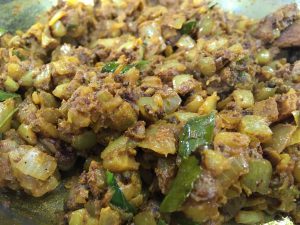Chinese Rolls
(3 hours, makes 50)

Chinese rolls (whether made with meat, chicken, or vegetarian) are an essential Sri Lankan party food. People look forward to them with anticipation, and greets their arrival with glee. They’re also a sign of love—in college and after, whenever I visited home, my mother or one of my aunts would make sure that when I left again, it was with a bag of freshly-fried rolls. It was sometimes a little challenging managing the still-steaming bag on the airplane, but it was the sort of gift that was impossible to turn down—made with love and labor, and eventually consumed with delight.
I believe they’re called Chinese rolls because they look a little like Chinese egg rolls; during colonial times, Chinese laborers were brought to Sri Lanka and settled there in a small but significant minority community; I assume this dish was invented then. They taste nothing like egg rolls, though.
Growing up, my sisters and I would often be pressed into service for the various stages of roll-making, all sitting around the dining table and working. My mother and aunts made them in a group as well. Especially if doing a larger batch, I highly encourage cooking this dish as a group activity (perhaps inviting a few select friends to come a few hours before your party), which will speed things up by as much as an hour. The final step is best done right before serving.
Portion and serving suggestion:
For a cocktail or other large-ish party, I’d aim for two rolls per guest. It’s a filling, rich treat. The recipes scales up or down easily—my mother would generally make 200 at a time, or more, for the Sri Lankan-American parties of my childhood, when immigrant families would gather, hungry for a taste of home. The dish is complex and labor-intensive enough that I woudn’t normally make rolls for a small dinner party, but you certainly could serve them as an appetizer, allowing two per person. Simply divide the recipe as needed.
Note: There are several points in the process where you can pause, refrigerate or freeze, and pick up again later. This is tremendously helpful when prepping for a party—you can do the bulk of the work days, weeks, or even months in advance, as long as you plan appropriately.
For the filling:
6 medium onions, chopped fine
1/4 cup vegetable oil + 1/2 cup vegetable oil
1/4 tsp black mustard seed
1/4 tsp cumin seed
1-2 TBL red chili powder
1 TBL Sri Lankan curry powder
2 lbs ground beef (or goat, or chicken)
1/3 cup ketchup
3 TBL Worcestershire sauce
1 tsp salt + 1 tsp salt
3 medium russet potatoes, diced in roughly 1/2-inch cubes
(Note: for a vegetarian filling, see the cutlets recipe.)
For the crepes:
4 cups cold water
2 cups milk
2 tsp salt
2 eggs
4 cups of all-purpose flour
For frying:
2 eggs
2 cups breadcrumbs
4 cups vegetable oil
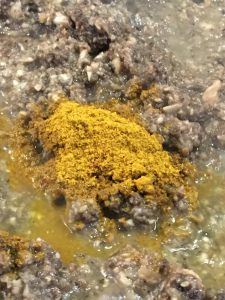
1. In a large frying pan, sauté onions in 1/4 cup oil on medium-high with mustard seed and cumin seeds until onions are golden/translucent (not brown). Add chili powder and cook 1 minute. Immediately add curry powder, ground beef, ketchup, Worcestershire sauce, and 1 tsp salt. Sauté until cooked through. Drain any excess oil, transfer to a large bowl, and let cool. (You can refrigerate for a few days or freeze for up to six months here.)
2. In a clean frying pan, heat 1/4 cup oil and fry potato cubes with 1 tsp salt on medium-high, stirring, until cooked through. Drain any excess oil and let cool. (You can refrigerate or freeze here—to best preserve potato texture for freezing, spread them out in a flat sheet and freeze, then transfer to large plastic sealable bags.)
3. Combine meat and potato mixture. (You can refrigerate or freeze here.)
4. Make crepes: Combine crepe filling ingredients and mix thoroughly until it forms a thin pancake batter. Heat an 8-inch non-stick frying pan and grease with a little oil between each pancake. Pour a ladle full of batter into the pan and swirl it around gently until it forms a thin pancake. Cook until set without browning; flip and briefly cook other side. Remove and stack on a plate. (If you have a friend with you, you can do steps 4 and 5 together, one making the crepes while the other fills.)
5. Place a cooked pancake on a plate and add about 2 TBL of filling. Proceed to roll the pancake like an egg-roll. Note: Try eating one or two at this stage (not required, but recommended, as there’s something deliciously unctuous about them, and I always used to steal some at this point when rolling for my mom).
7. In a small bowl, beat 2 eggs. Set up a plate piled with bread crumbs. Dip rolls in egg mixture, then roll in breadcrumbs, then remove to a separate plate. (Don’t pile them up, as they’ll squish — use multiple clean plates.) Continue until all rolls are encased in bread crumbs.
8. Heat vegetable oil in a large pan until quite hot, then, using a Chinese spider (recommended) or spatula, fry until golden, removing to separate plates lined with paper towels. (I usually turn the heat down a little after the first batch, which helps avoid burning them.) Serve hot as an appetizer, with a little spicy sauce (MD sauce can be found online, and is a classic choice) as accompaniment if desired.


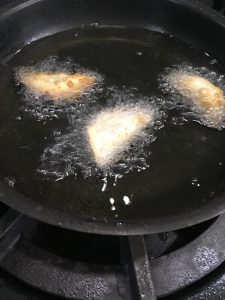

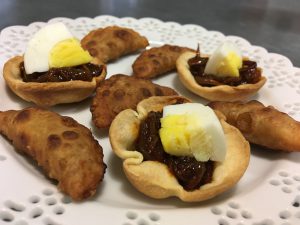

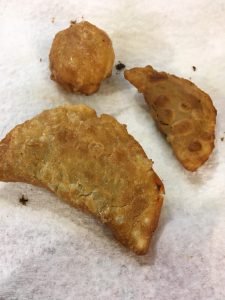

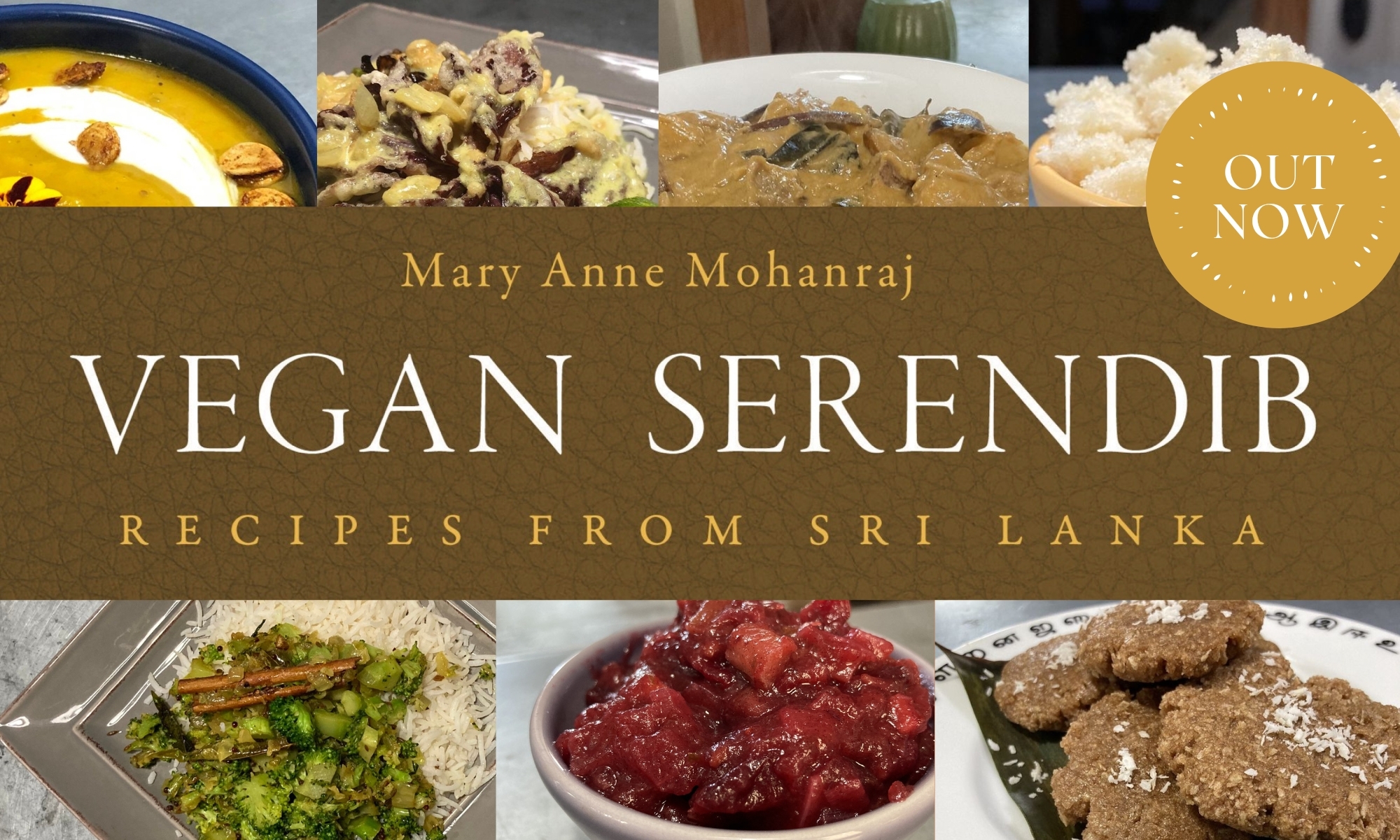

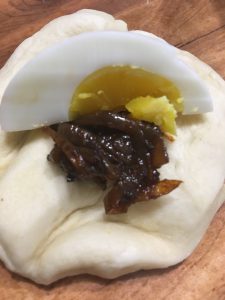
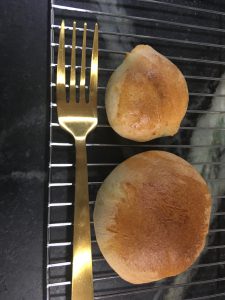
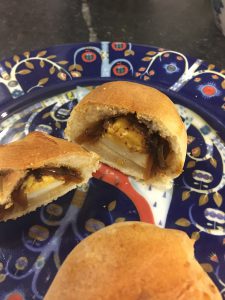

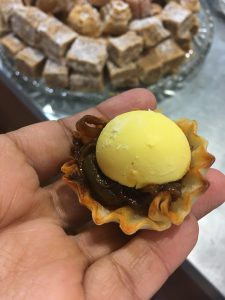


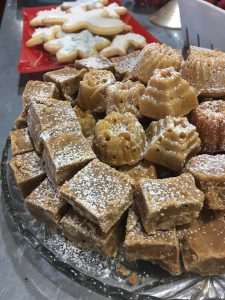
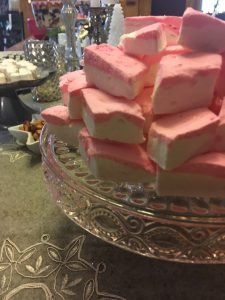


 I ran out of canola oil while setting up to deep-fry these; luckily Kat (who lives across the way) had some coconut oil she could send over with a child. So I fried in a combo of the two, which I think was perhaps perfect — the canola gave the characteristic crispiness, and the coconut gave some extra richness. I hadn’t fried in coconut oil before, though, and was really surprised when I put the first patty in — it foamed up dramatically (which may have had something to do with combining the two oils — I’m not sure)! I called Kevin over to make sure I wasn’t doing something wrong. But all was very well, and they were soon devoured. (Pictured below is a double-batch, filling three plates.)
I ran out of canola oil while setting up to deep-fry these; luckily Kat (who lives across the way) had some coconut oil she could send over with a child. So I fried in a combo of the two, which I think was perhaps perfect — the canola gave the characteristic crispiness, and the coconut gave some extra richness. I hadn’t fried in coconut oil before, though, and was really surprised when I put the first patty in — it foamed up dramatically (which may have had something to do with combining the two oils — I’m not sure)! I called Kevin over to make sure I wasn’t doing something wrong. But all was very well, and they were soon devoured. (Pictured below is a double-batch, filling three plates.)